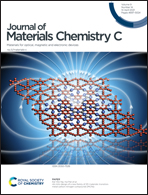Efficient solution-processed deep-blue CIEy ∈ (0.05) and pure-white CIEx,y ∈ (0.34, 0.32) organic light-emitting diodes: experimental and theoretical investigation†
Abstract
In this work, two bipolar non-conjugated deep-blue emitters, PICFOCz and BICFOCz, were synthesized by incorporating the charge transporting carbazole (donor/hole transporting) and imidazole (acceptor/electron-transporting) moieties via a flexible alkyl spacer. Systematic studies found that the incorporation of an alkyl spacer between the donor and acceptor not only increases the triplet energy but also effectively suppresses the intermolecular interaction. Both the emitters feature a CIE of y < 0.08 with ultra-deep blue emission, close to the National Television Standards Committee (NTSC) standard (0.14, 0.08). A solution-processed-organic light-emitting diode device consisting of BICFOCz displays a maximum external quantum efficiency (EQE) of 3.40% with Commission Internationale de L’Eclairage (CIE) coordinates of (0.17, 0.05). Inspired by the unique benefits of the deep-blue fluorophore and the high efficacy of long-wavelength triplet emitters, solution-processed white OLED devices were also fabricated by optimizing the orange-red emitter Ir(2-phq)3 composition. Pure white emission with CRI > 75 was realized by controlling the concentration of the phosphors; especially, the 3.0 wt% orange-red dye-containing OLED device showed a maximum current efficiency of 29.3 cd A−1, power efficiency of 19.7 lm W−1, EQE of 11.5%, and CRI of 70 with CIE coordinates of (0.44, 0.38), while pure-white emission was observed for the 0.5 wt% orange-red dye-based device with CIE coordinates of (0.35, 0.32) and a CRI of 76, which are very crucial for smart display (high-quality flat panel display) and lighting (including solid-state lighting) applications.



 Please wait while we load your content...
Please wait while we load your content...